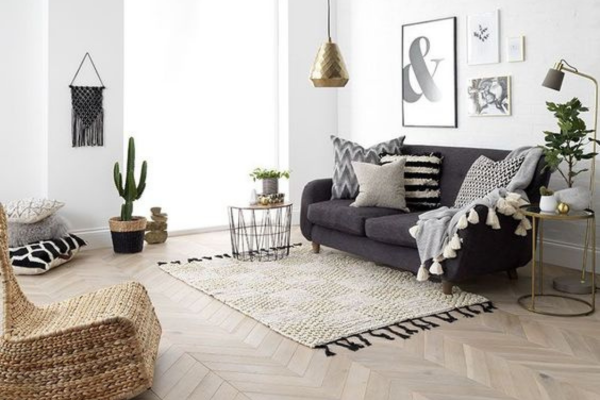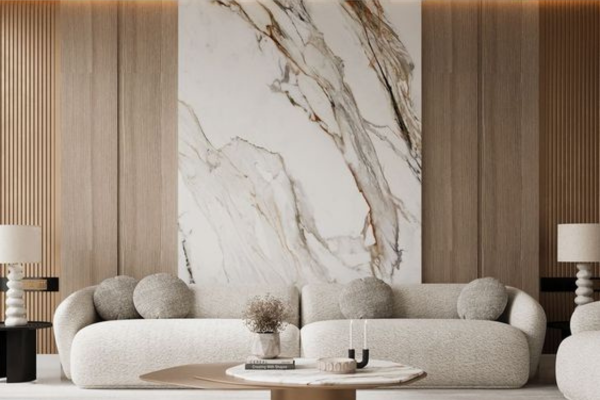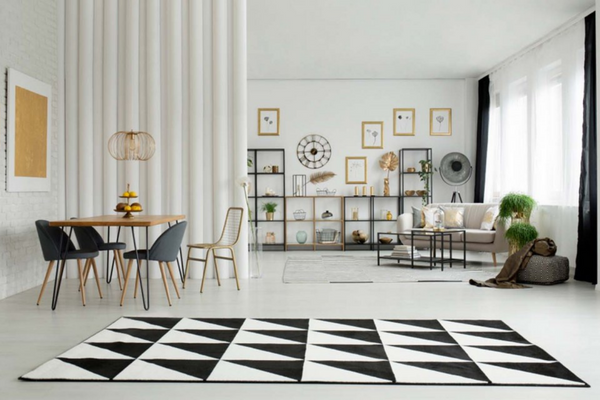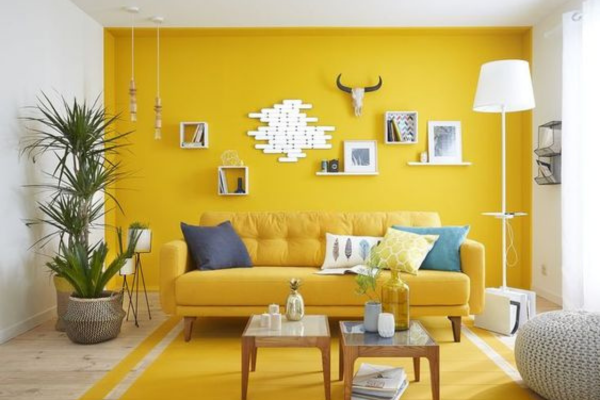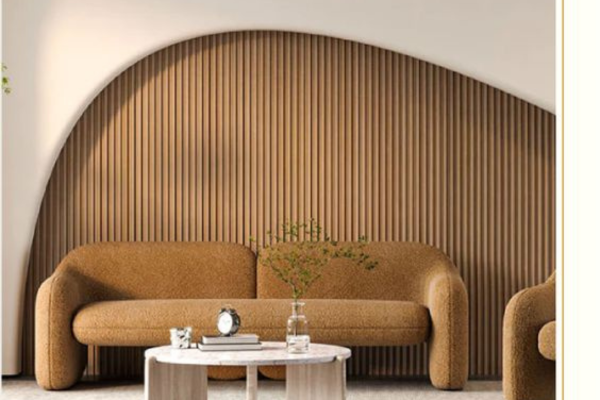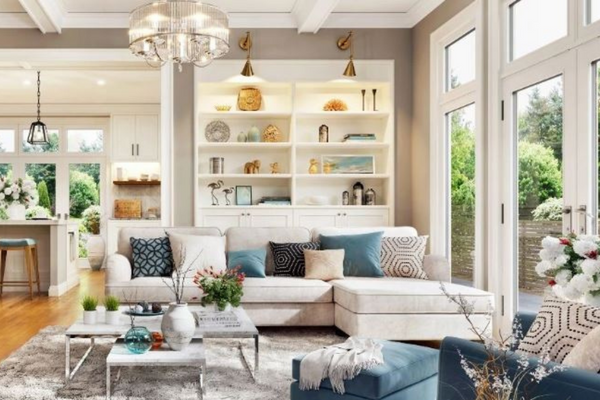“For a house to be successful, the objects in it must communicate with one another, respond and balance one another.”
-Andre Putman
Interior design is a complex art form encompassing a wide range of elements, from colours and textures to furniture and lighting, to provide a better, more aesthetically attractive environment for its users.
Balance ensures that visual weight is distributed harmoniously, unity creates a cohesive and harmonious feel, rhythm introduces a sense of movement, emphasis highlights focal points, and scale ensures that elements are proportionate to the space.
By incorporating the fundamental principles of balance, unity, rhythm, emphasis, and scale, you can create commercial and residential transformations that are both visually pleasing and functional.
Unity & Harmony
These fundamental principles of design include balance, unity, rhythm, emphasis, and scale helps to build the interior design portfolio of the space. But, unity and harmony are the most essential elementa for creating a cohesive and visually appealing space. Designers use a consistent theme, colour palette, or style throughout a room to achieve unity. However, harmony is achieved when all of the elements in a space work together to create a sense of balance and equilibrium.
Various ways to achieve unity are used, e.g., using a consistent colour palette, repeating patterns or shapes and choosing furniture and accessories that resemble each other’s style. For example, a blue and white colour palette, inspired by seashells, patterns, driftwood and accents could be found in a living room with a coastal theme.
There will be harmony when each element in the room is balanced and proportionate to one another. This includes furniture, accessories and architectural features in size, scale, colour or texture. A large sofa might be balanced by a pair of oversized armchairs, or a heavy coffee table might be offset by a lightweight rug.
Balance
Balance refers to the distribution of visual weight in a room. There are two main types of balance: symmetrical and asymmetrical. Proportional balance is achieved by arranging elements evenly on either side of an imaginary axis. Asymmetrical balance is more complex and involves carefully placing elements of different sizes, shapes, and colours to create a sense of balance and harmony.
In a room, balance means the distribution of lightweight. The two most commonly occurring types of balance are complementarity and asymmetry. The elements are arranged equally on each side of the imaginary axis to achieve symmetry. Asymmetrical equilibrium is not easy to achieve, and the way you put each element of a particular size, shape or colour needs to be designed to create an illusion of balance and harmony.
In public spaces, for instance, family rooms and kitchens, asymmetric balances are more common. To achieve that, furniture can be grouped in different areas of the room or used with complementary colours and textures to create a feeling of visual interest.
Scale & Proportion
Scale and proportion refer to the size of objects about each other and the overall space. Choosing furniture and décor that is appropriately sized for the room is essential to create a sense of balance and proportion.
The size of a room, ceiling height and the volume of other objects must be considered when selecting furniture and accessories for your home. Use different scales to create an appealing space, using proportion to balance it.
Rhythm and Repetition
Rhythm and repetition create a sense of movement and flow in a room. This can be achieved by repeating colours, patterns, or shapes throughout the space. For example, using the same colour for throw pillows, curtains, and an area rug can create a rhythmic pattern.
To create a sense of unity and harmony, repetition may also be used. For instance, achieving a cohesive and visually convincing look is possible by placing two pairs of matching lamps on the bedside table or grouping three images on one wall.
Emphasis & Contrast
Emphasis and contrast are used to draw attention to specific elements in a room. This can be achieved by using contrasting colours, textures, or sizes. For example, an accent wall with a bold colour or a striking piece of art can serve as an emphasis point.
To achieve a feeling of visual interest and balance, contrast can also be used. It may be possible to create a dramatic contrast when you place your white couch against dark walls; for example, mixing sleek coffee tables with luxurious rugs can enhance the sense of texture.
Details
Details can make or break a design. Attention to finer aspects, such as trim, moulding, and hardware, can elevate a space. Well-chosen details add depth and character to interiors.
For example, crown moulding to a ceiling can add a touch of elegance, or unique cabinet hardware can give a kitchen a personal touch. A great deal of influence on a room’s overall appearance and mood can be found even in tiny details, like the use of fresh flowers or painting a critical image.
Light
Lighting plays a vital role in interior design. Natural light, artificial fixtures, and their placement can profoundly impact a room’s ambience. A well-lit space is inviting and functional, while poor lighting can make even the most beautiful design fall flat.
The most appropriate source of illumination is natural light, wherever possible. It provides a pleasant illumination, which helps create the illusion of space. Nevertheless, artificial illumination, in particular during the evening hours, is very much needed. The types, intensities and colours of light they produce should be considered when selecting artificial lighting equipment.
Colour
Colour is one of the most influential elements in interior design. Each colour has psychological effects, and designers carefully select palettes to evoke specific moods. Warm colours like red, orange and yellow create cosiness, energy, warmth and excitement. It may make a comfortable, inviting atmosphere in the room. For example, a red accent wall in the living room could offer a touch of drama and excitement, while a yellow kitchen might make it bright and cheerful.
Calm, relaxation and calm are often accompanied by cool colours such as blue, green or purple. It is possible to create a peaceful and quiet environment by using them. For instance, a blue bedroom can create a relaxing atmosphere for sleep, while a green bathroom can create a spa-like feeling. A base for colour palettes is often neutral colours such as white, grey, and beige. They can be used to create a clean and modern look or matched with accent colours to create a more dynamic and visually exciting atmosphere.
Texture
Texture adds tactile and visual interest to a room. It can be introduced through textiles, materials, and finishes. In a space, this can contribute to its depth, dimension and visual interest. Different types of textures may also produce various moods and atmospheres. A room’s rustic and earthy feel can be enhanced by rough textures such as brick, stone or wood. You can also use them to make you feel warmer and more comfortable.
Graceful textures such as glass, metal and marble can achieve a modern, elegant appearance. They can also be used to create a sense of luxury and sophistication. A relaxing and inviting atmosphere can be brought to the room by gentle textures such as fabrics, rugs or pillows. They’re also suitable for making you feel warm and soft.
Space
The proper utilisation of space is crucial in interior design. The arrangement of furniture and decor should maximise functionality and circulation while ensuring that the room feels open and uncluttered.
In the home’s design, it is also essential to consider lousy space. It’s a space in the vicinity of furniture and accessories. A sense of balance and harmony in a room may be helped by negative space.
Function
Finally, good interior design always considers function; form follows function. Every space should cater to the needs and lifestyle of its occupants. The layout and choice of furniture should align with the room’s purpose, whether it’s a cosy living room or a functional kitchen.
Ensuring the room is appropriately used when designing a space is essential. The furniture must be designed in such a way that it maximises the functionality and circulation of the room but also ensures its openness and clearance from obstructions. Inadequate space must also be considered in the house’s design. It’s a blank spot right next to furniture and accessories. Negative space may help us to feel balanced and harmonious in the room.
In conclusion, interior design is not merely about aesthetics, but it’s a means to enhance your quality of life. Your home should reflect your personality, offer a refuge from the outside world, and cater to your needs and desires.
Whether it’s a cosy reading nook, a vibrant and inspiring workspace, or a tranquil bedroom, interior design has the power to transform your surroundings into a sanctuary where you can truly be yourself, recharge, and relish the beauty of life. With thoughtful design, you can turn your living space into a haven that resonates with your unique essence, promoting well-being and contentment in every corner of your life.
A summary of the 11 fundamental principles in interior design, offering essential guidance to enthusiasts and professional interior designers in London or elsewhere globally for crafting balanced and aesthetically pleasing interiors, brought to you by Oraanj Interior Design.
Author: Aisha Singh & Rutuja Borade (Interior Designer)

